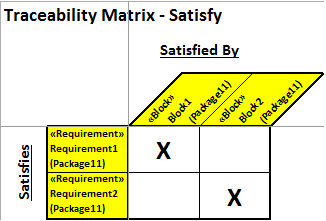Overview of traceability matrices and tables (SysML diagram)
The SysML and UML Standard profiles provide the following traceability relationships:
• Copy
• Derive Reqt
• Refine
• Satisfy
• Trace
• Verify
Having defined traceability relationships in the model, you can generate Traceability Matrices and Traceability Tables to show traceability relationships between items in a model.
Traceability relationships
The SysML and UML Standard profiles provide the following traceability relationships:
|
Relationship
|
Source Item
|
Destination Item
|
Description
|
Related topics
|
|---|---|---|---|---|
|
Copy
|
Requirement
|
Requirement
|
Links a master Requirement to a slave Requirement.
|
|
|
Derive Reqt
|
Requirement
|
Requirement
|
Links a Requirement to Requirements that are derived from it.
|
|
|
Refine
|
Model item
|
Model item
|
Links an item to other items that refine that item.
|
|
|
Satisfy
|
Model item
|
Requirement
|
Links a Requirement to items that satisfy that Requirement.
|
|
|
Trace
|
Model item
|
Model item
|
A general purpose link to link an item to other related items.
|
|
|
Verify
|
Model item
|
Requirement
|
Links a Requirement to items that verify the Requirement.
|
Traceability matrices

A Traceability Matrix shows how items are related to other items through a selected traceability relationship type, that is, Copy, Derive Reqt, Refine, Satisfy, Trace or Verify.
When you open a Traceability Matrix, Modeler creates a table that can be generated as HTML for viewing in your Internet browser, or generated as a Microsoft Excel spreadsheet for viewing in Microsoft Excel. Each time you open a Traceability Matrix, Modeler populates that matrix with the latest data from the model. To specify how matrices and tables are opened for a model: in the Packages pane, right-click the Model, and select > , click Matrix/Table Generation Format, and then select HyperTextMarkupLanguage_HTML or Excel_XLS.
Modeler creates a row for each valid source item that is found in the analyzed Packages, and a column for each valid target items of the source items. A cell containing and X indicates that the two associated items are linked through a Copy, Derive Reqt, Refine, Satisfy, Trace or Verify relationship, depending on the type of the Traceability Matrix.
For more information about Traceability Matrices, see the following topics:
Traceability tables

A Traceability Table shows how items are related to other items through a selected traceability relationship type, that is, Copy, Derive Reqt, Refine, Satisfy, Trace or Verify.
When you open a Traceability Table, Modeler creates a table that can be generated as HTML for viewing in your Internet browser, or generated as a Microsoft Excel spreadsheet for viewing in Microsoft Excel. Each time you open a Traceability Table, Modeler populates that table with the latest data from the model. To specify how matrices and tables are opened for a model: in the Packages pane, right-click the Model, select > , click Matrix/Table Generation Format, and then select HyperTextMarkupLanguage_HTML or Excel_XLS.
Modeler creates a row for each valid source item that is found in the analyzed Packages, and the columns show valid target items of the source items. You can add additional columns to show other properties of the table items.
For more information about Traceability Tables, see the following topics: